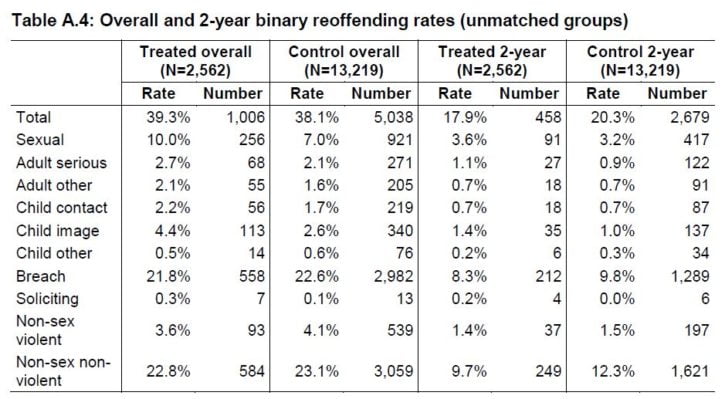Negative impact
Last Friday (30 June 2017) the MoJ published its Impact evaluation of the prison-based Core Sex Offender Treatment Programme, possibly unique in MoJ analytical series reports for being heavily trailed in the Daily Mail.
The report made headlines because it appears that sex offenders on the treatment programme were found to have a higher proven reoffending rate than a comparison group who didn’t do the treatment.
The programme
Core SOTP is a cognitive-behavioural psychological intervention designed by the HM Prison and Probation Service (HMPPS) for imprisoned men who have committed sexual offences. The Programme is intended to reduce sexual reoffending amongst participants by identifying and addressing known criminogenic needs. It was accredited for use in prisons in 1992 by the then HM Prison and Probation Service Prison and Probation Services Joint Accreditation Panel, which later became the Correctional Services Accreditation and Advice Panel (CSAAP).
Changes have been made to the targets, the content, and the methods used in Core SOTP since its introduction in response to emerging research. As a result, during the course of this study (and in the period thereafter) the Programme has changed. However, it remains a cognitive behavioural group based treatment approach. It was, and remains, available in approximately one-sixth of male prison establishments in England and Wales and is intended for individuals sentenced to 12 months or more, who had either a current or previous (sentence) sex offence, were willing to engage in treatment, and were not in denial of their offending.
The research
There were 2,562 convicted sex offenders who started treatment under the prison-based Core Sex Offender Treatment Programme between 2000 and 2012 in England and Wales. These were matched to 13,219 comparison sex offenders using 87 matching factors from Police National Computer (PNC) records, SOTP treatment records, and the Offender Assessment System (OASys) database (where available).
Propensity score matching (PSM) was used to match sexual offenders who participated in Core SOTP (treated sex offenders) to similar sexual offenders who did not.
The matched treatment and comparison groups were then compared on an extensive range of proven reoffending outcomes (sexual and non-sexual). These outcome measures were calculated over a period of up to 13.9 years (average of 8.2 years) starting from each offender’s release from prison between 2002 and 2012, with the follow-up period finishing in October 2015.
The findings
Some statistically significant differences were detected over an average 8.2 year follow up period. They were small in magnitude although they widened over the follow-up period. In particular:
- More treated sex offenders committed at least one sexual reoffence (excluding breach) during the follow-up period when compared with the matched comparison offenders (10.0% compared with 8.0%).
- More treated sex offenders committed at least one child image reoffence during the follow-up period when compared with the matched comparison offenders (4.4% compared with 2.9 %).
- Otherwise, the matched treated and comparison groups had similar reoffending rates across a variety of outcome measures.

Conclusions
The MoJ impact evaluation concludes:
The results suggest that while Core SOTP in prisons is generally associated with little or no changes in sexual and non-sexual reoffending, there were some statistically significant differences. The small changes in the sexual reoffending rate suggest that either Core SOTP does not reduce sexual reoffending as it intends to do, or that the true impact of the Programme was not detected.
It is possible that a number of factors (such as motivation, participation in other treatment programmes and data quality) might limit the validity of the study. However, this is an unusually large treatment and comparison group, followed up for a long period with the matching quality described as “excellent.”
Implications
There are very many implications to this study which raises a number of key questions. Some of the most important ones for me are:
- Why does an evidence-based programme have no impact — and is possibly even counter-productive — on reoffending?
- Given that many offenders have had their prison sentences extended because of delays in getting on SOTP, what are the implications for sex offenders still in prison who have either completed or are waiting to do the SOTP?
- Why has the MoJ and new Justice Minister David Lidington not issued a formal statement setting out HMPPS future plans for addressing the behaviour of sex offenders in prison and supervising them on release?
I realise that the issue is complex and disorienting to policy makers and practitioners alike but it’s simply not good enough for the MoJ not to address it directly and imply that the programme has changed and, therefore, things might be all right now.
Whatever you think of the press coverage of this issue, there’s no denying that it is of great public interest that our core response to sex offending does not work.
Given the difficulties in detecting and prosecuting many sexual offences, with many crimes against children and adults hidden and “proven reoffending” (reconviction) rates inevitably an under-estimate, we owe it to past and future victims of sexual offences to set out a clear strategy which minimises the risk of reoffending.
Although the evaluation was only published last week, it has been common knowledge in the MoJ for several months. I’d like to see the MoJ set a clear direction about what it intends to do next — surely the press office can do more than report on which criminal justice staff Sam Gyimah has met this week?
All prison posts are kindly sponsored by Prison Consultants Limited who offer a complete service from arrest to release for anyone facing prison and their family. Prison Consultants have no editorial influence on the contents of this site.









7 Responses
How justified has it been to delay release for 100s of indeterminate prisoners to either complete these programmes or where they have been deemed ‘not to have gained ‘ from them. Surely this is a case for judicial review ?
How justified has it been to delay release for 100s of indeterminate prisoners in order to either complete these programmes or where they have been deemed ‘not to have gained ‘ from them. Surely this is a case for judicial review ? How many more will be delayed to complete new programmes.
One thing that isn’t clear at the moment is whether the comparison group may have included people who were innocent – and therefore did not participate in treatment because they were “denying” their offence. If this was the case, and I’m not expert enough to tell from the MoJ evaluation whether this was something that was controlled for, then it wouldn’t be surprising that the comparison group had a lower reoffending rate since it would have included a number of people who had never committed a sexual offence and were, therefore, unlikely to do so again. I’m hoping we will get some sort of statement from the MoJ about what happens next.
please contact I have infomation
I’m a bit cynical about Propensity Score Matching (PSM) – basically it’s an attempt to recreate what happens in the very first step of creating an actuarial risk assessment instrument, except that the actuarial measures are then subject to re-validation, modification and further validation. Whenever someone uses PSM, my immediate thought is why not just use a validated actuarial tool? (e.g., STATIC-99R). If you are going to add factors over and above the actuarial tool, why didn’t those factors cut the mustard in the actuarial tool construction process?
That said, the usual result is that people who attend treatment are ultimately lower risk than those who don’t. For general reoffending the difference is usually about 15 percentage points (e.g., 45% v 30%). So if there is any bias here after the PSM, it probably favours the treatment group. Denial is unassociated with reoffending, but refusal to do programs is. No amount of statistical tricks like PSM can deal with the unknown, unmeasured factors that drive some offenders to comply with treatment, and others to refuse, but there is a clear association with recidivism.
The MOJ finding is similar to one that was conducted in Australia recently http://www.bocsar.nsw.gov.au/Documents/CJB/Report-2016-Custody-based-Intensive-Treatment-(CUBIT)-program-cjb193.pdf so there may be something fundamentally wrong with how research evidence is translated into actual treatment.
Thanks very much for your comment Richard. I think the programme raises real questions about how much impact interventions (and interveners) can have on reoffending – not that we should stop trying. Certainly, there are very few approaches analysed by the Justice Data Lab which see anything near a 15 percentage point drop.
PROZAC CHEMICAL CASTRATION WORKS,OR SURGICAL CASTRATION